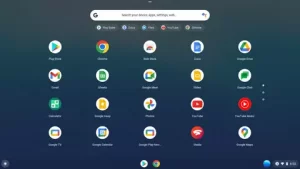While Chromebooks may not be as popular as they were in 2020, they’re still a useful piece of hardware, and since it’s a relative newcomer to the PC market, many people don’t even know what a Chromebook is. Simply put, Google Chromebooks are like Windows and Mac computers, except that they run Google’s Chrome OS, and all-in-one desktops using Chrome OS, called Chromebases, are also available.
Chrome OS runs both web-based and Android apps, and unlike the mobile-focused Android OS, Chrome OS has a user interface similar to Microsoft Windows or macOS. The mouse and keyboard play a key role in its design, and users can easily move and resize multiple windows. The operating system has a taskbar and launcher that resembles the Windows taskbar and start menu.
However, understanding a Chromebook helps to take a closer look at what a Chromebook can and can’t do.
What is a Chromebook?

A Chromebook is a device built on Google tools. You need a Google account to sign in. The device’s settings are synced with your Google account, and it can connect to an Android phone to share files, sync chat notifications, send text messages, and use the phone network.
The operating system is equipped with Google Assistant, which allows you to issue voice commands by saying, “Hey, Google.” Google’s web-based productivity tools appear in the Start menu by default, along with several other apps and services created by Google. The taskbar at the bottom of the screen has Google Chrome and the Google Play Store in the middle.
Although the Chromebook is web-centric, it can be used offline without problems. Even cloud-based services like Google Docs and Google Sheets have a fully functional offline mode that lets you edit files on the Chromebook whenever possible. It will sync with Google the next time you connect to the Internet.
Can Chromebooks run Android apps?
Chromebooks can access most Android apps from the Play Store, and if you’ve downloaded or purchased an app using your Android phone or tablet, you’ll likely be able to use the app on your Chromebook.
Although most available apps are usable, not all are designed with Chromebooks in mind. For example, Google’s Family Link app, which provides parental controls for Chromebooks and Android devices, is designed for mobile phones, so by default, it’s displayed in portrait, phone-sized format.
Many Android apps have similar problems with phone or tablet-oriented design. If your Chromebook doesn’t have a touchscreen, this can be frustrating for apps designed for touch and multi-touch capabilities, but Google is now working on a fix.
Can Chromebooks install Linux?
Modern Chromebooks can install a Linux development environment, specifically the Debian 10 GNU/Linux distribution, which allows users to install Linux applications, IDEs, and other tools on their Chromebooks. You can also open a terminal to run Linux commands, use the APT package manager, and customize the shell.
Linux famously gives users access to a wide range of free and open-source software, and many programs available on Windows also have Linux-compatible versions.
However, this feature is relatively new and has some major limitations. Notably, you can’t access your Chromebook’s camera using Linux, and you can’t use GPU hardware acceleration, nor can you use Linux-based Android emulators. However, that’s a big deal on devices already compatible with Android. Is not.
What can’t the Chromebook do?
With access to the Google Play Store, Linux, and the entire web, it’s possible that a Chromebook can do anything you want it to do, but there are still things it can’t do. For example, apps specifically made to run on a Windows PC, or Mac won’t run on a Chromebook.
Also, some apps that run on Android phones are disabled for Chromebooks, including the MS Office Suite. However, the web-based version is fully functional.
There are also features on some Android phones that Chromebooks can’t run, including:
- GPS
- deep red
- Camera flash
- Camera autofocus
- Barometer
Any Android app that requires the above features or anything else in incompatible Google manifest entries will not install.
Also, for some reason, you can’t put any files or shortcuts on your desktop. When all windows are closed, Chromebook users can see their chosen wallpaper unobstructed, and whatever they want to use is moved to the bottom bar. This doesn’t pose any major performance issues, but it’s an unusual design.
Why buy a Chromebook?
Although their incompatibility with Windows and Mac-based applications is not desirable, Chromebooks may still be worth buying for your family. Affordable Chromebooks, typically costing between $200 and $350, are well suited for the average user’s day-to-day use, such as office software, video chat, email, social media, and general web browsing. They are also designed to be more secure than Windows PCs, meaning an inexperienced user is less likely to crash or infect the system with a virus.
A high-end Chromebook will be useful for people who enjoy opening dozens of tabs and multiple hardware programs simultaneously. They’re also a must-have for anyone who wants to fully explore the Chromebook’s Linux capabilities or try out any game on Steam. Additionally, the Chromebook’s ability to sync with Android devices adds value, along with its compatibility with millions of apps in the Google Play Store.